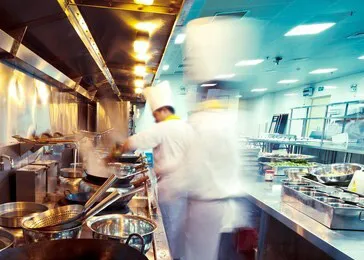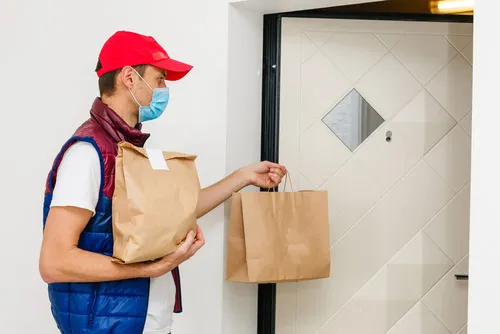“As demand for food delivery has skyrocketed, the definition of what constitutes a restaurant has become increasingly flexible. Renting space for a dining room? Waitstaff? Tables and chairs? Optional. The only requirement is a kitchen.” - Garrett Snyder, Los Angeles Times, September 2020
With Halloween being celebrated around the world this weekend, ghosts might be appearing in your neighbourhood - but hopefully it’s nothing more than children dressing up and having some fun! Of course, that’s all part of an old tradition that goes with the occasion.
Ghost kitchens, meanwhile, are a much newer phenomenon. And thankfully, they don’t involve any demons or spirits coming out at night to haunt restaurant cooking facilities! They’re nothing to get spooked about, even at Halloween, but given the time of year we’ve decided to look into them a little further.
So what exactly is a ghost kitchen?
A ghost kitchen is a professional food preparation and cooking facility, set up for the preparation of meals for delivery-only, with no customer-facing shop front.
It contains the kitchen equipment and facilities needed for the preparation of restaurant-quality meals, but does not have a dining area for walk-in customers. That’s where this business model differs from a traditional restaurant-kitchen environment.
Ghost kitchens generally do business and take orders entirely online, using modern digital ordering solutions. These digital ordering capabilities, along with the surge in demand for food delivery services over recent years, are the major driving forces in their growing prevalence all over the world.
For many people starting out in the restaurant sector, a ghost kitchen is a more affordable way to get up and running without so much of the usual expensive overheads. You don’t need as many staff or as much space. You just need a food preparation kitchen where delivery drivers can pick up the orders for distribution.
Don’t get scared off by some of the terminology either! Various terms are used interchangeably. A ghost kitchen may also be commonly known as a dark kitchen, virtual restaurant, delivery kitchen, shadow kitchen or cloud kitchen. These all essentially refer to the same kind of facility, which has no dine-in service or physical customer-facing aspect.

Are ghost kitchens a major industry trend?
Ghost kitchens have risen to prominence over the last several years and now represent big business and big money. They could actually be a $1 trillion global market by 2030, according to one leading analyst.
In 2018, the financial research firm UBS projected that the global food delivery market would grow by 13.5% annually for the foreseeable future, compared with a much more moderate 3% growth in the overall restaurant industry. And that’s before even factoring in the surge in demand for delivery during the COVID-19 pandemic in 2020.
So delivery is on a rapid growth trajectory and ghost kitchens are very much part of that story. They are now the favoured model for many food-service businesses.
There are also some long-standing challenges in the industry contributing to this. Many restaurants have traditionally relied on operating at high-profile, city-centre locations to bring in customers. That usually means high rents, while providing dine-in services to a good standard also brings major overheads.
With the high cost of doing business, many owners have struggled and been forced to close. The coronavirus pandemic has of course exacerbated this situation further, with lockdown measures forcing many more dine-in restaurants to shut their doors.
So, for many restaurants, the regular bricks-and-mortar model has become unprofitable and unviable. However, the rapid rise of food delivery and customers’ changing food consumption habits has shifted the landscape. Diners are becoming more and more comfortable with food delivery all the time.
That’s where ghost kitchens come in and present an opportunity for independent restaurant and chain operators to do things a different way.

What are the benefits of setting up a ghost kitchen?
If you are an aspiring restaurateur, opening and operating an independent ghost kitchen can be significantly more affordable and profitable than owning a full-service restaurant. You can avoid all of the costs associated with front-of-house floor space, decor, furnishings and wait staff.
As well as that, ghost kitchens don’t rely on a high-footfall, central location to bring in customers. The physical location is not as much of a priority since the brand operates entirely online. This means that the high rents that often come with a high street location can be avoided in favour of a more cost-effective option. Many ghost kitchens operate in areas on the outskirts of major cities in more industrial settings.
In addition, ghost kitchens can be kitted out and updated quickly to produce particular cuisine types and meet consumer demand, without closing or disrupting the business for renovations. Ghost kitchens are a way to significantly increase productivity, widen the scope for providing delivery and build a larger customer base.
The money you save on rent and other overheads can instead be invested in quality produce, great chefs and fast delivery.
Of course, this doesn’t mean you neglect brand building or marketing efforts. On the contrary, you can put major emphasis on doing this through digital channels, building up your online brand and reaching customers where they are - on their smartphones and ready to order food delivery.


